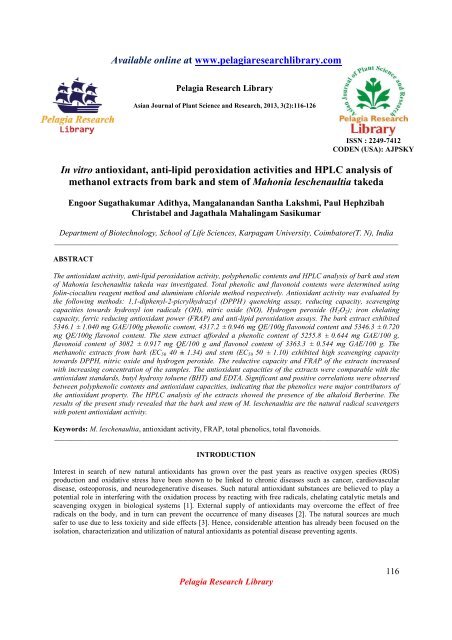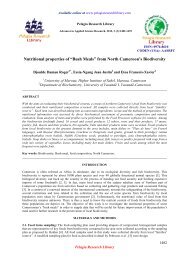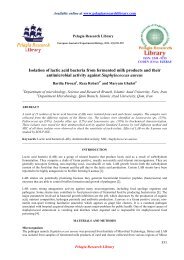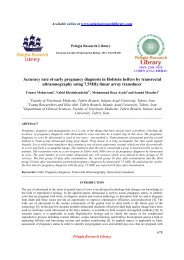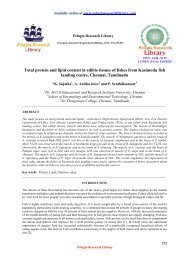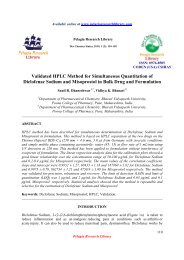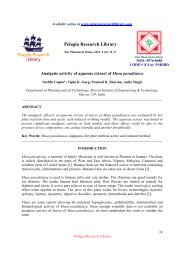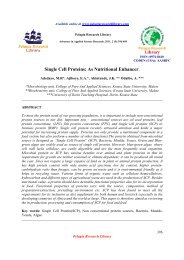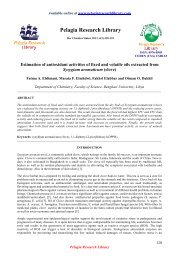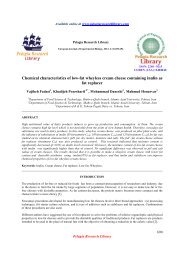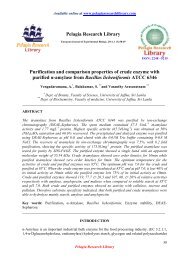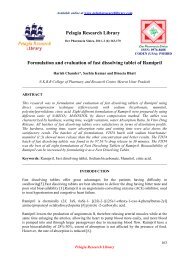In vitro antioxidant, anti-lipid peroxidation activities and HPLC ...
In vitro antioxidant, anti-lipid peroxidation activities and HPLC ...
In vitro antioxidant, anti-lipid peroxidation activities and HPLC ...
You also want an ePaper? Increase the reach of your titles
YUMPU automatically turns print PDFs into web optimized ePapers that Google loves.
Available online at www.pelagiaresearchlibrary.com<br />
Pelagia Research Library<br />
Asian Journal of Plant Science <strong>and</strong> Research, 2013, 3(2):116-126<br />
ISSN : 2249-7412<br />
CODEN (USA): AJPSKY<br />
<strong>In</strong> <strong>vitro</strong> <strong><strong>anti</strong>oxidant</strong>, <strong>anti</strong>-<strong>lipid</strong> <strong>peroxidation</strong> <strong>activities</strong> <strong>and</strong> <strong>HPLC</strong> analysis of<br />
methanol extracts from bark <strong>and</strong> stem of Mahonia leschenaultia takeda<br />
Engoor Sugathakumar Adithya, Mangalan<strong>and</strong>an Santha Lakshmi, Paul Hephzibah<br />
Christabel <strong>and</strong> Jagathala Mahalingam Sasikumar<br />
Department of Biotechnology, School of Life Sciences, Karpagam University, Coimbatore(T. N), <strong>In</strong>dia<br />
_____________________________________________________________________________________________<br />
ABSTRACT<br />
The <strong><strong>anti</strong>oxidant</strong> activity, <strong>anti</strong>-<strong>lipid</strong> <strong>peroxidation</strong> activity, polyphenolic contents <strong>and</strong> <strong>HPLC</strong> analysis of bark <strong>and</strong> stem<br />
of Mahonia leschenaultia takeda was investigated. Total phenolic <strong>and</strong> flavonoid contents were determined using<br />
folin-ciocalteu reagent method <strong>and</strong> aluminium chloride method respectively. Antioxidant activity was evaluated by<br />
the following methods: 1,1-diphenyl-2-picrylhydrazyl (DPPH . ) quenching assay, reducing capacity, scavenging<br />
capacities towards hydroxyl ion radicals ( . OH), nitric oxide (NO), Hydrogen peroxide (H 2 O 2 ); iron chelating<br />
capacity, ferric reducing <strong><strong>anti</strong>oxidant</strong> power (FRAP) <strong>and</strong> <strong>anti</strong>-<strong>lipid</strong> <strong>peroxidation</strong> assays. The bark extract exhibited<br />
5346.1 ± 1.040 mg GAE/100g phenolic content, 4317.2 ± 0.946 mg QE/100g flavonoid content <strong>and</strong> 5346.3 ± 0.720<br />
mg QE/100g flavonol content. The stem extract afforded a phenolic content of 5255.8 ± 0.644 mg GAE/100 g,<br />
flavonoid content of 3082 ± 0.917 mg QE/100 g <strong>and</strong> flavonol content of 3363.3 ± 0.544 mg GAE/100 g. The<br />
methanolic extracts from bark (EC 50 40 ± 1.34) <strong>and</strong> stem (EC 50 50 ± 1.10) exhibited high scavenging capacity<br />
towards DPPH, nitric oxide <strong>and</strong> hydrogen peroxide. The reductive capacity <strong>and</strong> FRAP of the extracts increased<br />
with increasing concentration of the samples. The <strong><strong>anti</strong>oxidant</strong> capacities of the extracts were comparable with the<br />
<strong><strong>anti</strong>oxidant</strong> st<strong>and</strong>ards, butyl hydroxy toluene (BHT) <strong>and</strong> EDTA. Significant <strong>and</strong> positive correlations were observed<br />
between polyphenolic contents <strong>and</strong> <strong><strong>anti</strong>oxidant</strong> capacities, indicating that the phenolics were major contributors of<br />
the <strong><strong>anti</strong>oxidant</strong> property. The <strong>HPLC</strong> analysis of the extracts showed the presence of the alkaloid Berberine. The<br />
results of the present study revealed that the bark <strong>and</strong> stem of M. leschenaultia are the natural radical scavengers<br />
with potent <strong><strong>anti</strong>oxidant</strong> activity.<br />
Keywords: M. leschenaultia, <strong><strong>anti</strong>oxidant</strong> activity, FRAP, total phenolics, total flavonoids.<br />
_____________________________________________________________________________________________<br />
INTRODUCTION<br />
<strong>In</strong>terest in search of new natural <strong><strong>anti</strong>oxidant</strong>s has grown over the past years as reactive oxygen species (ROS)<br />
production <strong>and</strong> oxidative stress have been shown to be linked to chronic diseases such as cancer, cardiovascular<br />
disease, osteoporosis, <strong>and</strong> neurodegenerative diseases. Such natural <strong><strong>anti</strong>oxidant</strong> substances are believed to play a<br />
potential role in interfering with the oxidation process by reacting with free radicals, chelating catalytic metals <strong>and</strong><br />
scavenging oxygen in biological systems [1]. External supply of <strong><strong>anti</strong>oxidant</strong>s may overcome the effect of free<br />
radicals on the body, <strong>and</strong> in turn can prevent the occurrence of many diseases [2]. The natural sources are much<br />
safer to use due to less toxicity <strong>and</strong> side effects [3]. Hence, considerable attention has already been focused on the<br />
isolation, characterization <strong>and</strong> utilization of natural <strong><strong>anti</strong>oxidant</strong>s as potential disease preventing agents.<br />
Pelagia Research Library<br />
116
Engoor Sugathakumar Adithya et al Asian J. Plant Sci. Res., 2013, 3(2):116-126<br />
_____________________________________________________________________________<br />
Mahonia leschenaultia takeda, belonging to family Berberidaceae, is a shrub with rough, greyish-brown, corky<br />
bark. It is locally called Thovari by the Todas, the Nilgiri tribe. The paste of the stem bark is used by them in<br />
postnatal treatment in women [4]. Methanol extract of M. leschenaultia fruits were found to possess high level of<br />
anthocyanin, ascorbic acid, total phenolics <strong>and</strong> flavonoids <strong>and</strong> high <strong><strong>anti</strong>oxidant</strong> activity [5]. <strong>In</strong> vivo <strong><strong>anti</strong>oxidant</strong> <strong>and</strong><br />
nephroprotective <strong>activities</strong> of ethanol extract of M. leschenaultia on acetaminophen induced toxicity in rats were<br />
studied previously [6]. However, there has been no detailed study on the in <strong>vitro</strong> <strong><strong>anti</strong>oxidant</strong> activity of stem <strong>and</strong><br />
bark of M. leschenaultia. The objective of this study was to explore <strong><strong>anti</strong>oxidant</strong> activity, <strong>anti</strong>-<strong>lipid</strong> <strong>peroxidation</strong><br />
activity <strong>and</strong> polyphenolic <strong>and</strong> berberine contents of methanolic extracts from bark <strong>and</strong> stem of M. leschenaultia.<br />
MATERIALS AND METHODS<br />
2.1. <strong>In</strong>struments <strong>and</strong> Chemicals<br />
The ultraviolet (UV) spectra were recorded on Elico SL 177, <strong>In</strong>dia UV-visible (UV-VIS) spectrophotometer. All<br />
chemicals including the solvents were of analytical grade; 1,1-diphenyl-2-picryl hydrazyl (DPPH), quercetin,<br />
butylated hydroxyl toluene (BHT) were purchased from Merck Chemical Co., Mumbai, <strong>In</strong>dia. Gallic acid was<br />
acquired from Riedel-de-Hahn, Germany.<br />
2.2. Plant Material<br />
The plant M. leschenaultia was taxonomically identified <strong>and</strong> authenticated by Dr. R. Gopalan, Taxonomist,<br />
Karpagam University, Coimbatore, <strong>In</strong>dia. The plant was collected from Pykara forest range, Ootacamund, Nilgiri<br />
District, Tamil Nadu, <strong>In</strong>dia during June 2009. The bark <strong>and</strong> stem was washed in tap water, dried <strong>and</strong> stored until<br />
further analysis.<br />
2.3. Preparation of Extract<br />
The bark <strong>and</strong> stem samples (100 g) were shade dried <strong>and</strong> mechanically powdered separately to obtain a course<br />
powder, which was then subjected to extraction in a Soxhlet apparatus with 5 times its volume of methanol (1:5 v/v).<br />
The extracts were concentrated in vacuo at 40 ± 1 0 C by rotary flash evaporator (Buchi type Rota vapor,<br />
Switzerl<strong>and</strong>) under reduced pressure to obtain the dry extracts. The dry extracts were re-dissolved in methanol <strong>and</strong><br />
the stock solutions was kept at -4 0 C to protect from light until further use. The stock solutions were used to<br />
determine total phenolics, total flavonoids, total flavonols <strong>and</strong> <strong><strong>anti</strong>oxidant</strong> capacity.<br />
2.4. Total Phenolic Content<br />
The total phenolic content in the methanolic extract of M. leschenaultia was determined using Folin-Ciocalteu<br />
phenol reagent method [7]. Briefly, diluted extract (I mL) was added with diluted Folin-Ciocalteau reagent (1 N, 1<br />
mL). After 3 min of reaction, Sodium carbonate (Na 2 CO 3 ) (35%, 2 mL) was added <strong>and</strong> the mixture was incubated<br />
for 30 min at room temperature. The absorbance was read at 765 nm using UV-Vis spectrophotometer (Shimadzu,<br />
Kyoto, Japan). The analyses were performed in triplicates. The total phenolic content was expressed as mg gallic<br />
acid equivalents from a gallic acid st<strong>and</strong>ard curve (mg GAE/100 g fresh mass, R 2 = 0.9968).<br />
2.5. Total Flavonoid Content<br />
The determination of total flavonoid content in the M. leschenaultia extract was based on the method reported<br />
previously [8]. The absorbance was measured at 510 nm using UV-Vis spectrophotometer with reference st<strong>and</strong>ard<br />
prepared with quercetin concentrations. The analyses were performed in triplicate. The total flavonoid content was<br />
estimated from a quercetin st<strong>and</strong>ard curve <strong>and</strong> the results were expressed as mg quercetin equivalents (mg QE/100 g<br />
fresh material, R 2 = 0.9665).<br />
2.6. Total flavonol Content<br />
Total flavonols in the plant extracts were estimated using the method described previously [9]. To 2.0 mL of sample<br />
(st<strong>and</strong>ard), 2.0 mL of 2% AlCl 3 in ethanol (2%) <strong>and</strong> 3.0 mL (50 g/L) sodium acetate solutions were added. The<br />
absorption at 440 nm was read after 2.5 h at 20°C. Extract samples were evaluated at a final concentration of 0.1<br />
mg/ ml. Total flavonoid content was calculated as quercetin (mg/g) using the following equation based on the<br />
calibration curve: y = 0.0255x, R 2 = 0.9812, where x was the absorbance <strong>and</strong> was the quercetin equivalent (mg/g).<br />
2.7. Scavenging Capacity towards DPPH· Stable Radical<br />
The determination of DPPH· scavenging activity of the M. leschenaultia extract was based on the method as<br />
described previously [10]. Briefly, 1 mL of aliquots of the extract <strong>and</strong> st<strong>and</strong>ards (20-100 µg mL -1 ) was added to<br />
Pelagia Research Library<br />
117
Engoor Sugathakumar Adithya et al Asian J. Plant Sci. Res., 2013, 3(2):116-126<br />
_____________________________________________________________________________<br />
immediately at 593 nm. The calibration curve was plotted with absorbance vs concentration of FeSO 4 in the range of<br />
0-1 mM <strong>and</strong> the total <strong><strong>anti</strong>oxidant</strong> activity was expressed as µmol Fe (II)/ g extract.<br />
2.13. Reductive Capacity (RC)<br />
The reducing capacity of the extracts was measured using the potassium ferricyanide reduction method [16].<br />
Various concentrations of the extract <strong>and</strong> st<strong>and</strong>ards (25-500 µg mL -1 ) were added to 2.5 mL of (0.2 M) sodium<br />
phosphate buffer (pH 6.6) <strong>and</strong> 2.5 mL of potassium ferricyanide [K 3 Fe 3 (CN) 6] (1%) solution <strong>and</strong> vortexed. After<br />
incubation at 50°C for 20 min, 2.5 ml of TCA (10%, w/v) was added to all the tubes <strong>and</strong> centrifuged (Remi, <strong>In</strong>dia) at<br />
3000 x g for 10 min. Afterwards, upper layer of the solution (5 mL) was mixed with deionized water (5 mL). To<br />
this, 1 mL of FeCl 3 (1%) was added to each test tube <strong>and</strong> incubated at 35°C for 10 min. The formation of Perl’s<br />
Prussian colour was measured at 700 nm in a UV-Vis spectrophotometer. <strong>In</strong>creased absorbance of the reaction<br />
mixture indicated increasing reducing power. BHT was used for comparison.<br />
2.14. Chelating Capacity (CC)<br />
The Fe 2+ chelating capacity (CC) was investigated according to the method described earlier [17]. Briefly, different<br />
concentrations of both the extracts <strong>and</strong> st<strong>and</strong>ards (50-250 µg mL -1 ) were mixed FeCl 2 (2 mM) <strong>and</strong> ferrozine (5 mM).<br />
The mixture was made into 0.8 mL with deionized water. After 10 min incubation at room temperature, the<br />
absorbance of ferrous ion-ferrozine complex was measured at 562 nm in UV-Vis spectrophotometer. EDTA was<br />
used as reference st<strong>and</strong>ard. The percentage of chelation was calculated as follows:<br />
Ferrous ion chelating capacity (%) = 1-Sample 562nm /Control 562nm x100,<br />
Where, Sample 562nm was absorbance of the sample <strong>and</strong> Control 562nm was absorbance of control.<br />
2.15. <strong>HPLC</strong> analysis<br />
The berberine content was identified by using analytical <strong>HPLC</strong> method. The analytical <strong>HPLC</strong> system (P-40000,<br />
Thermo separation products, USA) employed consisted of a quaternary <strong>HPLC</strong> pump, photodiode array detector<br />
(UV 6000 LP) <strong>and</strong> a recorder. <strong>HPLC</strong> analysis was performed using a water prevail C18 analytical column<br />
(15 cm × 4.6 mm id, 5µm particle size; ALTech, IL, USA) was used. The auto-injection system (spectra<br />
system-AS 3000) consisted of a 20 µl sample loop. The mobile phase consisted of 20% acetonitrile in aqueous<br />
formic acid (v/v). The Peak responses were detected at 280 nm using UV detector. <strong>In</strong> both cases, a flow rate of<br />
1.0 mL/min was maintained. Identification <strong>and</strong> peak assignment of the compound was based on comparison of its<br />
retention time with corresponding st<strong>and</strong>ard <strong>and</strong> by spiking of sample with the st<strong>and</strong>ard. Qu<strong>anti</strong>fication of the<br />
compound was done using total peak area <strong>and</strong> each peak with external st<strong>and</strong>ard.<br />
2.16. Statistical analysis of data<br />
The experimental data were reported as mean ± S.D of three parallel measurements. Linear regression analysis was<br />
performed quoting the correlation coefficient.<br />
RESULTS<br />
The total phenol content of bark was 534.61 ± 1.040 mg gallic acid equivalents (GAE)/100 g dry matter <strong>and</strong> that of<br />
stem was 525.58 ± 0.644 mg gallic acid equivalents (GAE)/100g. Total flavonoid content of bark was 431.72 ±<br />
0.946 mg QE/100g of dry matter <strong>and</strong> that of stem was 308.2 ± 0.917 mg quercetin equivalents (QE)/100g. The<br />
content total flavonol in bark extract was found to be 534.63 ± 0.720 mg quercetin equivalents (QE)/100g DM <strong>and</strong><br />
that in stem was 336.33 ± 0.544 mg QE/100g (Table 1).<br />
Table 1. Total phenol, flavonoid <strong>and</strong> flavonol contents of M. leschenaultia extracts<br />
Polyphenol Bark Extract Stem Extract<br />
Total Phenol a 534.61 ± 1.040 525.58 ± 0.644<br />
Total Flavonoid b 431.72 ± 0.946 308.20 ± 0.917<br />
Total Flavonol b 534.63 ± 0.720 336.33 ± 0.544<br />
Pelagia Research Library<br />
119
Engoor Sugathakumar Adithya et al Asian J. Plant Sci. Res., 2013, 3(2):116-126<br />
_____________________________________________________________________________<br />
Each value in the table was obtained by calculating the average of three experiments (n=3), ± st<strong>and</strong>ard deviation. a<br />
mg gallic acid equivalents (GAE)/100g dry weight, b mg quercetin equivalents (QE)/100g dry weight.<br />
The DPPH free radical scavenging ability increased sharply with the increase in concentration of the methanolic<br />
extract. Based upon the measured EC 50 values, the DPPH· quenching ability of M. leschenaultia bark, stem <strong>and</strong> the<br />
st<strong>and</strong>ard (BHT) was found to be 40 ± 1.34 µg mL -1 , 50 ± 1.10 µgmL -1 <strong>and</strong> 26.12 ± 0.04 µg mL -1 respectively (Table<br />
2).<br />
As illustrated in Table 2, the extracts were capable of inhibiting OH˙ radical formation in concentration dependent<br />
manner. The EC 50 value of bark (190 + 0.89 µg mL -1 ) <strong>and</strong> stem (150 + 1.40 µg mL -1 ) extracts were significantly<br />
(P
Engoor Sugathakumar Adithya et al Asian J. Plant Sci. Res., 2013, 3(2):116-126<br />
_____________________________________________________________________________<br />
Figure 1. ALP % of methanol extracts of bark <strong>and</strong> stem of M. leschenaultia<br />
The reduction of ferrous ion (Fe3+) to ferric ion (Fe2+) is measured by the intensity of the resultant blue-green<br />
solution which absorbs at 700 nm. Figure 2 shows the concentration dependent increase in reducing capacity in<br />
terms of absorbance values at 700 nm. The reducing power of the bark extract (0.471 ± 0.013) <strong>and</strong> stem extract<br />
(0.428 ± 0.014) at a dosage of 100 µg/mL was found to be below that of BHT (0.688 ± 0.044).<br />
Figure 2. Reducing capacity of methanol extracts of bark <strong>and</strong> stem of M. leschenaultia<br />
The methanol extract of M. leschenaultia revealed a concentration dependent increase in chelating capacity (Figure<br />
3). The iron chelating capacity of bark extract, stem extract <strong>and</strong> positive control were found to be 31%, 25.5 % <strong>and</strong><br />
55.63% at a concentration of 100µg/ml.<br />
<strong>HPLC</strong> method enabled qualitative <strong>and</strong> qu<strong>anti</strong>tative analysis of Berberine in M. leschenaultia. From the calibration<br />
curve results, the amount of Berberine, in the sample injected was calculated. The amount of Berberine in bark (0.97<br />
mg/kg) was similar to that in stem (0.98 mg/kg). The chromatogram of Berberine st<strong>and</strong>ard, stem <strong>and</strong> bark are given<br />
as Figure 4, Figure 5 <strong>and</strong> Figure 6 respectively. Peak 1 in both figure 1 <strong>and</strong> figure 2 represents Berberine.<br />
Pelagia Research Library<br />
121
Engoor Sugathakumar Adithya et al Asian J. Plant Sci. Res., 2013, 3(2):116-126<br />
_____________________________________________________________________________<br />
Figure 3. Chelating capacity of methanol extracts of bark <strong>and</strong> stem of M. leschenaultia<br />
Figure 4. <strong>HPLC</strong> analysis of Berberine st<strong>and</strong>ard<br />
Pelagia Research Library<br />
122
Engoor Sugathakumar Adithya et al Asian J. Plant Sci. Res., 2013, 3(2):116-126<br />
_____________________________________________________________________________<br />
Figure 5. <strong>HPLC</strong> analysis of M. leschenaultia stem extract<br />
Figure 6. <strong>HPLC</strong> analysis of M. leschenaultia bark extract<br />
Parameters Stem Extract Bark Extract St<strong>and</strong>ard<br />
RT (min/sec) 3:45 3:50 4:47<br />
Content (mg/kg) 0.98 0.97 0.98<br />
The TPC of bark extract exhibited an apparent linear relationship with DPPH radical scavenging activity (r 2 = 0.98),<br />
nitric oxide radical scavenging activity (r 2 = 0.97), hydrogen peroxide scavenging activity (r 2 = 0.98), reducing<br />
capacity (r 2 = 0.97) <strong>and</strong> hydroxyl scavenging activity (r 2 = 0.96). The TPC of stem extract also exhibited linear<br />
relationship with DPPH radical scavenging activity (r 2 = 0.99), nitric oxide radical scavenging activity (r 2 = 0.99),<br />
hydrogen peroxide scavenging activity (r 2 = 0.98), reducing capacity (r 2 = 0.96) <strong>and</strong> hydroxyl scavenging activity (r 2 =<br />
0.97). The TFC of bark was well correlated with DPPH radical scavenging activity (r 2 = 0.98), reducing power (r 2 =<br />
0.97), hydroxyl radical scavenging activity (r 2 = 0.96), nitric oxide scavenging activity (r 2 = 0.97) <strong>and</strong> hydrogen<br />
peroxide scavenging activity (r 2 = 0.98).<br />
Pelagia Research Library<br />
123
Engoor Sugathakumar Adithya et al Asian J. Plant Sci. Res., 2013, 3(2):116-126<br />
_____________________________________________________________________________<br />
DISCUSSION<br />
The <strong><strong>anti</strong>oxidant</strong> activity of medicinal plants is mainly related to their phenolic compounds [18]. Polyphenol are the<br />
major plant compounds <strong>and</strong> are commonly found in both edible <strong>and</strong> inedible plants <strong>and</strong> they have been reported to<br />
have multiple biological effects, including <strong><strong>anti</strong>oxidant</strong> activity. Their <strong><strong>anti</strong>oxidant</strong> activity is mainly due to their<br />
redox properties, hydrogen donors <strong>and</strong> singlet oxygen quenchers, which can play an important role in adsorbing <strong>and</strong><br />
neutralizing free radicals, quenching singlet <strong>and</strong> triple oxygen, or decomposing peroxides. The importance of the<br />
<strong><strong>anti</strong>oxidant</strong> constituents of plant materials in the maintenance of health <strong>and</strong> protection from coronary heart disease<br />
<strong>and</strong> cancer is also raising interest among scientists, food manufacturers <strong>and</strong> consumers [19].<br />
<strong>In</strong> the view of the up surging interest in the health benefits of the medicinal plants, we examined total phenolics,<br />
flavonoids <strong>and</strong> flavonols <strong>and</strong> evaluated the <strong><strong>anti</strong>oxidant</strong> properties of bark <strong>and</strong> stem extracts of M. leschenaultia. The<br />
bark extract features a subst<strong>anti</strong>al content of total phenolics as compared with stem extract. The total phenolic<br />
content was comparatively higher than the total flavonoid <strong>and</strong> flavonol contents. The total phenolic content in bark<br />
<strong>and</strong> stem of M. leschenaultia is higher when compared to 70% aqueous methanolic extracts of its fruits [5]. Previous<br />
reports revealed that methanol extract of M. leschenaultia bark <strong>and</strong> stem extracts possess more content of flavonoids<br />
than its fruit extract [5].<br />
DPPH is a stable nitrogen-centred free radical the colour of which changes from violet to yellow upon reduction by<br />
either the process of hydrogen or electron donation. Substances which are able to perform this reaction can be<br />
considered as <strong><strong>anti</strong>oxidant</strong>s <strong>and</strong> therefore radical scavengers [20]. It was found that the radical scavenging <strong>activities</strong><br />
of bark <strong>and</strong> stem extracts increased with increasing concentration. The bark extract possessed more hydrogen<br />
donating ability than the stem extract <strong>and</strong> it was comparable to that of BHT. The DPPH scavenging activity of bark<br />
<strong>and</strong> stem was higher than that exhibited by its fruit extract [5]. The DPPH scavenging capacity of the plant extracts<br />
may be related to the phenolic compounds present [21].<br />
Hydroxyl radical (˙OH), the most reactive free radical, has the capacity to conjugate with nucleotides in DNA, cause<br />
str<strong>and</strong> breakage, <strong>and</strong> lead to carcinogenesis, mutagenesis <strong>and</strong> cytotoxicity [22]. <strong>In</strong> this study, M. leschenaultia<br />
extracts inhibited the degradation of 2-deoxyribose in a dose dependent manner. The bark extract exhibited higher<br />
activity than the stem extract, but the hydroxyl radical scavenging activity of both the extracts was lower than that of<br />
BHT. Earlier studies showed that bark <strong>and</strong> stem extracts of M. leschenaultia hold low activity than the fruit extracts<br />
of some Berberidaceae members [23].<br />
<strong>In</strong> addition to reactive oxygen species, NO is also implicated in chronic inflammation, cancer <strong>and</strong> other pathological<br />
conditions. The NO generated from SNP at physiological pH reacts with oxygen (O 2 ) to form nitrite ions. The<br />
methanol extracts of M. leschenaultia competed with O 2 to react with nitrite ions <strong>and</strong> thus inhibits the NO<br />
generation. Here, the stem extract possessed higher scavenging <strong>activities</strong> than the bark extract. Here also the bark<br />
<strong>and</strong> the stem extracts showed lesser scavenging activity than that of BHT. Fruit extracts of some members of the<br />
family Berberidaceae showed more NO scavenging activity than bark <strong>and</strong> stem of M. leschenaultia [23].<br />
Hydrogen peroxide is an important ROS formed in vivo by many oxidizing enzymes such as superoxide dismutase.<br />
It has a strong oxidizing property with the ability to penetrate biological membranes. Hydrogen peroxide itself is not<br />
very reactive, but can sometimes be toxic to cells when it gives rise to hydroxyl radical in the cells [24]. The bark<br />
<strong>and</strong> stem extracts of M. leschenaultia were capable of scavenging H 2 O 2 in a concentration dependent manner. Bark<br />
of M. leschenaultia showed more scavenging capacity than the stem.<br />
Lipid <strong>peroxidation</strong>, which is widely recognized as primary toxicological event, is caused by the generation of free<br />
radicals from a variety of sources including organic hydro peroxides, redox cycling compounds <strong>and</strong> iron-containing<br />
compounds. The TBARS assay has been used to measure the degree of <strong>lipid</strong> <strong>peroxidation</strong>. TBA reacts specifically<br />
with malondialdehyde (MDA), a secondary product of <strong>lipid</strong> <strong>peroxidation</strong> to give a red chromogen, which may then<br />
be determined spectrophotometrically [25]. <strong>In</strong> this study, both bark <strong>and</strong> stem extracts were capable of preventing the<br />
formation of MDA in a dose dependent manner. But the highest <strong>anti</strong>-<strong>lipid</strong> <strong>peroxidation</strong> activity was revealed by the<br />
bark extract of M. leschenaultia than the stem extract. This assay revealed that the extracts might prevent reactive<br />
radical species from damaging biomolecules such as lipoprotein, DNA, amino acids, sugar, proteins <strong>and</strong> PUFA in<br />
biological <strong>and</strong> food systems.<br />
Pelagia Research Library<br />
124
Engoor Sugathakumar Adithya et al Asian J. Plant Sci. Res., 2013, 3(2):116-126<br />
_____________________________________________________________________________<br />
The ability of plant extracts to reduce Fe 3+ /Fe 2+ was determined by FRAP assay. FRAP assay measures the reducing<br />
capacity by increased sample absorbance based on the formed ferrous ions, <strong>and</strong> the assay may not be complete even<br />
several hours after the reaction starts, such that a single end-point of the reaction cannot be determined [26,27].The<br />
change in absorbance at 593 nm owing to the formation of blue coloured Fe 2+ - TPTZ complex from the colourless<br />
oxidized Fe 3+ form by the action of electron donating <strong><strong>anti</strong>oxidant</strong>s [28]. The FRAP value of bark extract was found<br />
to be higher than that of the stem extract. Since FRAP assay is easily reproducible <strong>and</strong> linearly related to molar<br />
concentration of the <strong><strong>anti</strong>oxidant</strong>s present, thus it can be reported that extracts of M. leschenaultia may act as free<br />
radical scavenger, capable of transforming reactive free radical species into stable non radical products.<br />
<strong>In</strong> the reducing power assay, the presence of <strong><strong>anti</strong>oxidant</strong>s in the bark <strong>and</strong> stem extracts of M. leschenaultia was able<br />
to convert the oxidized form of Fe 3+ into Fe 2+ which was measured by the intensity of the resultant Prussian blue<br />
color complex. With the increase of concentration, the absorbance of the extracts <strong>and</strong> the st<strong>and</strong>ard were found to be<br />
increased gradually [29]. Bark extract showed high reducing capacity than the stem extract <strong>and</strong> the reducing<br />
capacities of both bark <strong>and</strong> stem was lesser than that of BHT. Earlier reports suggests that bark <strong>and</strong> stem of M.<br />
leschenaultia holds low reducing capacity than fruits of some members of the same family [23]. The reducing<br />
capacity is generally associated with the presence of reductones <strong>and</strong> the <strong><strong>anti</strong>oxidant</strong> action of reductones is based on<br />
the breaking of the free radical chain by donating a hydrogen atom [30]. The result indicated that the marked<br />
reducing power of the bark <strong>and</strong> stem extracts seems to be due to the presence of polyphenols which may act in a<br />
similar fashion as reductones.<br />
The chelating <strong>activities</strong> for Fe 2+ of the extracts were assessed by the inhibition of formation of red-colored<br />
ferrozine <strong>and</strong> ferrous complex. The formation of the red complex was inhibited concentration-dependently in<br />
the presence of extracts. The data obtained from this assay demonstrated that the extracts of M. leschenaultia<br />
revealed an effective capacity for metal-binding, suggesting that they may play a protective role against oxidative<br />
damage by sequestering Fe 2+ ions. But the chelating capacity of M. leschenaultia was found to be lesser than<br />
Berberis tinctoria [22].<br />
It is widely accepted that the <strong><strong>anti</strong>oxidant</strong> activity of a plant extract is correlated to its phenolic content [31]. <strong>In</strong> the<br />
present study, strong correlations were observed between phenolic content <strong>and</strong> <strong><strong>anti</strong>oxidant</strong> activity. According to<br />
recent reports, the strong scavenging capacity of the extracts on DPPH, hydroxyl, nitric oxide, hydrogen peroxide<br />
radicals might possibly due to the phenolic compounds which could act as a hydrogen donor <strong><strong>anti</strong>oxidant</strong>. The<br />
<strong><strong>anti</strong>oxidant</strong> potential of polyphenols has been correlated to the capacity of donating hydrogen. The number <strong>and</strong> the<br />
configuration of H-donating hydroxyl groups are both important structural features influencing the <strong><strong>anti</strong>oxidant</strong><br />
capacity of phenolic compounds. [32]. Therefore, it was considered that the high <strong><strong>anti</strong>oxidant</strong> capacity of the bark<br />
<strong>and</strong> stem extract of M. leschenaultia could be attributable to its high amount of polyphenolic content.<br />
Berberine is a quaternary ammonium salt from the proto-berberine group of isoquinoline alkaloids. It is found in<br />
such plants as Berberis aquifolium, Berberis vulgaris <strong>and</strong> Tinospora cordifolia <strong>and</strong> to a smaller extent in Argemone<br />
mexicana <strong>and</strong> Eschscholzia californica. Berberine is usually found in the roots, rhizomes, stems <strong>and</strong> barks [33].<br />
During the last few decades, many studies have shown berberine has various beneficial effects on the cardiovascular<br />
system <strong>and</strong> significant <strong>anti</strong>-inflammatory [34] <strong>and</strong> <strong>anti</strong>microbial [35] <strong>activities</strong>. It exerts up-regulating activity on<br />
both low-density-lipoprotein receptor (LDLR) <strong>and</strong> insulin receptor (<strong>In</strong>sR). This one-drug-multiple-target<br />
characteristic might be suitable for the treatment of metabolic syndrome [36]. Berberine has been tested <strong>and</strong> used<br />
successfully in experimental <strong>and</strong> human diabetes mellitus [37]. <strong>In</strong> the present study, <strong>HPLC</strong> analysis of bark <strong>and</strong> stem<br />
extracts of M. leschenaultia revealed the presence of berberine. So the plant could act as a potent source of this<br />
multiple target alkaloid which can be used for impending drug development [38].<br />
CONCLUSION<br />
<strong>In</strong> this study we focused on <strong><strong>anti</strong>oxidant</strong> properties of bark <strong>and</strong> stem of M. leschenaultia. This study demonstrated<br />
that M. leschenaultia bark <strong>and</strong> stem extracts efficiently scavenged DPPH, OH˙, NO <strong>and</strong> H 2 O 2 in <strong>vitro</strong>. The plant<br />
showed good chelating capacity, reducing capacity <strong>and</strong> <strong>anti</strong>-<strong>lipid</strong> <strong>peroxidation</strong> activity. These <strong>activities</strong> of the plant<br />
were strongly correlated with its phenolic <strong>and</strong> flavonoid contents. <strong>HPLC</strong> analysis of the extracts revealed the<br />
presence of an important alkaloid Berberine, which is very frequently used in traditional medicinal system. As a<br />
result, bark <strong>and</strong> stem extracts of M. leschenaultia seem to be good sources of natural <strong><strong>anti</strong>oxidant</strong>s.<br />
Pelagia Research Library<br />
125
Engoor Sugathakumar Adithya et al Asian J. Plant Sci. Res., 2013, 3(2):116-126<br />
_____________________________________________________________________________<br />
Acknowledgments<br />
We are grateful to the Management of Karpagam University for providing facilities <strong>and</strong> encouragement.<br />
REFERENCES<br />
[1] B. Halliwell, Cardiovascular Res., 2007, 73, 341-7.<br />
[2] W. S. Choo, W. K. Yong, Adv. Appl. Sci. Res., 2011, 2(3), 418-425.<br />
[3] B. K. Kumawat, M. Gupta, T. Y. Singh, Asian J. Plant Sci. Res., 2012, 2(3): 323-329.<br />
[4] K. Raghunathan, V. N. K. Ramadas; Tribal pockets of Nilgiris, Recordings of the field study on Medicinal Flora<br />
<strong>and</strong> Health Practices, Central Council for Research in <strong>In</strong>dian Medicine <strong>and</strong> Homoeopathy, 2 nd edition, 1978, 102.<br />
[5] S. Karuppusamy, G. Muthuraja, K. M. Rajasekaran, <strong>In</strong>d. J. Nat. Prod. Res., 2011, 2, 174-178.<br />
[6] S. Palani, S. Raja, R. Santhosh, Kalash, B. Senthil Kumar, Toxicol. Environ. Chem., 2010, 92(4), 788-99.<br />
[7] V. Singleton, R. Orthofer, R. M. Lamuela-Raventos, Methods Enzymol., 1999, 299, 152-178.<br />
[8] A. A. L. Ordonez, J. D. Gomez, M. A. Vattuone, M. I. Isla, Food Chem., 2006, 97, 452-8.<br />
[9] A. Kumaran, R. J. Karunakaran, LWT-Food Sci. Technol., 2007, 40, 344-52.<br />
[10] R. P. Singh, K. N. Chidambara Murthy, G. K. Jayaprakash, J. Agric. Food Chem., 2002, 50, 86-9.<br />
[11] B. Halliwell, J. M. C. Gutteridge, O. J. Aruoma, Anal. Biochem., 1997, 165, 215-19.<br />
[12] L. C. Green, D. A. Wagner, J. Glogowsi, P. L. Skipper, J. S. Wishnok, S.R. Tannenbaum, Anal. Biochem.,<br />
1982, 126, 131-8.<br />
[13] R. T. Ruch, S. J. Cheng, J. E. Klaunig, Methods Enzymol., 1984, 5, 198-209.<br />
[14] M. Ohkowa, N. Ohisi, K. Yagi, Anal. Biochem., 1979, 95, 351-358.<br />
[15] I. F. F. Benzie, J. J. Strain, Anal. Biochem., 1996, 239, 70-6.<br />
[16] M. Oyaizu, Japanese J. Nutr., 1986, 44, 307-15.<br />
[17] N. Singh, P. S. Rajini, Food Chem., 2004, 85, 611-16.<br />
[18] N. Subhangkar, P. S Himadri, R. B. Nishith, C. Bodhisattwa, Asian J. Plant Sci. Res., 2012, 2(3): 254-262.<br />
[19] R. Shah, H. Kathad, R. Sheth, N. Sheth, <strong>In</strong>t. J. Pharm. Pharm. Sci., 2010, 2(3), 30‐33.<br />
[20] A. A. Dehpour, M. A. Ebrahimzadeh, S. F. Nabavi, S. M. Nabavi, Grasa Aceites, 2009, 60(4), 405-412.<br />
[21] V. Y. A. Barku, Y. Opoku-Boahen, E. Owusu-Ansah, E. F. Mensah, Asian J. Plant Sci. Res., 2013, 3(1): 69-74.<br />
[22] M. M. Naidu, G. Sulochanamma, S. R. Sampathu, P. Srinivas, Food Chem., 2008, 107, 377-384.<br />
[23] J. M. Sasikumar, V. Maheshu, A. G. Smilin, M. M. Gincy, C. Joji, <strong>In</strong>t. Food Res. J., 2012, 19(4), 1601-1607.<br />
[24] I. Gulcin, Z. Huyut, M. Elmastas, H. Y. Aboul-Enein, Arab. J. Chem., 2010, 3, 43-53.<br />
[25] P. P. Coppen, <strong>In</strong>: J. C. Allen, R. J. Hamilton (Eds.), Rancidity in foods (Applied Science Publishers, New York,<br />
USA, 1983) 67.<br />
[26] D. Jhade, S. Jain, A. Jain, P. Sharma, Asian Pac. J. Trop. Biomed., 2012, 2(2), S501-S505.<br />
[27] S. Arokiyaraj, N. Sripriya, R. Bhagya, B. Radhika, L. Prameela, N. K. Udayaprakash, Asian Pac. J. Trop.<br />
Biomed., 2012, 2(2), S601-S604.<br />
[28] A. D. Gupta, V. Pundeer, G. B<strong>and</strong>e, S. Dhar, I. R. Ranganath, G. S. Kumari, Pharmacol., 2009, 1, 200–208.<br />
[29] M. N. Amin, S. M. R. Dewan, W. Noor, A. F. M. Shahid-Ud-Daula, Euro. J. Exp. Bio., 2013, 3(1): 449-454.<br />
[30] M. H. Gordon, <strong>In</strong>: B. J. F. Hudson (Ed.), Food <strong><strong>anti</strong>oxidant</strong>s (Elsevier Applied Science, London, 1990) 1-18.<br />
[31] D. Choudhury, M. Ghosal, A. P. Das, P. M<strong>and</strong>al, Asian J. Plant Sci. Res., 2013, 3(1): 99-107.<br />
[32] V. Vadivel, H. K. Biesalski, <strong>In</strong>t. Food Res. J., 2012, 19(2), 593-601.<br />
[33] Q. Zhang, L. Cai, G. Zhong, W. Luo, Zhongguo, J Chin. Mater. Med., 2010, 16, 2061-2064.<br />
[34] C. L. Kuo, C. W. Chi, T. Y. Liu, Cancer Lett., 2004, 2, 127-137.<br />
[35] A. Singh, S. Duggal, K. Navpreet, J. Singh, J Nat. Prod., 2010, 3, 64-75.<br />
[36] W. Yan-Xiang, W. Yu-Ping, Z. Hao, K. Wei-Jia, L. Ying-Hong, L. Fei, G. Rong-Mei, L. Ting, Bioorg.<br />
Medicinal Chem. Lett., 2009, 19(21), 6004-8.<br />
[37] H. Zhang, J. Wei, R. Xue, Metabolism, 2009, 59(2), 285-92.<br />
[38] Y. Gu, Y. Zhang, X. Shi, Talanta, 2010, 81(3), 766-72.<br />
Pelagia Research Library<br />
126


